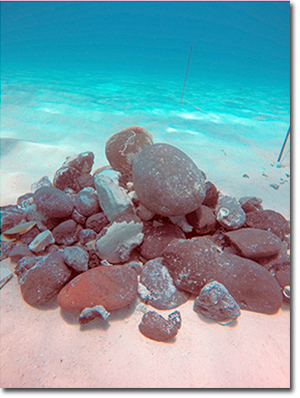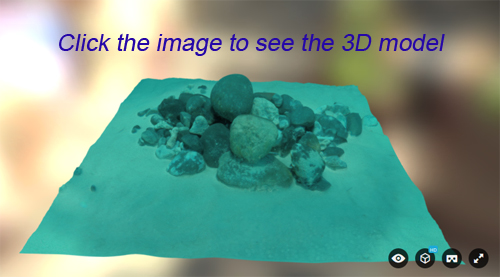Ballast 3D Model By Sean Cox 30 May 2016

Ballast pile removed from shipwreck while excavating (photo by S. Cox 2016).
"Ballast is exciting!" - Dr. Jennifer McKinnon
Ballast is not frequently the center of attention when discussing ships and shipwrecks. Whether in the popular vocabulary, which trends toward 'treasures', or in an archaeological context that examines 'food ways', cannons, trade goods, and the 'lived lives' of people aboard vessels, ballast is seldom the main attraction. Yet heavy objects placed in the bottoms of boats are the bedrock that keeps a ship upright, so I've decided to devote some ink to those we've recovered from the Pillar Dollar shipwreck.
Floridian waters are littered with shipwrecks, so it shouldn't be surprising that the coastline is likewise strewn with ballast refuse. The stones we have found look very similar to this one, Spanish shipwreck ballast pile, and we have moved stones ranging from those small enough to be palmed to others as big as a human head.
The stones, in and of themselves, aren't as impressive as other revelations from the site, but they were essential: "Aboard all vessels, ballast influences four main characteristics related to how a floating vessel sits in the water and reacts to changing conditions; these are stability, freeboard, draft, and trim." Put another way, ballast keeps the boat upright, keeps the bits that belong above and below the waterline in place under way, and maintains the ship's angle relative to the water while it moves.
Ballast is more than just the weight, it's the science of keeping a ship afloat, and it is an important one. Take the case of the Vasa, which sank on its maiden voyage: "It was discovered during outfitting of the ship that the shallow keel did not provide sufficient space in the hold for the amount of ballast needed to stabilize a 135-foot ship."
Without question, ballast is important to the functioning of a ship, but what can ballast remains tell archaeologists? This less-than-glamorous line of inquiry has contributed evidence to support the identities of certain shipwrecks, including the *Queen Anne's Revenge* and the Mollasses Reef Wreck.
Ballast stones can also carry organisms that may enable archaeologists to reconstruct the paths of the vessels that carried them.
Still, these unsung weights of the water can raise as many questions as they purport to answer, and their value in interpretive work is hotly debated. So, without comment as to their usefulness in our excavation, I've decided to share some of the ballast of the Pillar Dollar Wreck in a 3D model. Below is a model I've made of a stack of ballast stones we created while clearing one of the units:

ECU Pillar Dollar Ballast Pile Unit 5
Here are some other sources to explore ballast piles from shipwrecks around the world:
The Archaeology of Stone
Emanuel Point Shipwreck ballast
Vasa ballast
Previous Next

